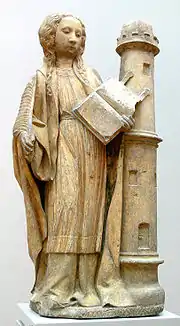Claus de Werve
Claus or Claux de Werve (c. 1380–1439) was a sculptor active at the Burgundian court under Philip the Bold between 1395 and 1439. He was probably born in the Dutch city of Haarlem around 1380.
Claus de Werve | |
|---|---|
 Virgin and the Child of Poligny the Metropolitan Museum | |
| Born | c. 1380 Haarlem |
| Died | 1439 Dijon |
| Nationality | Dutch |
| Other names | Claux de Werve |
| Occupation | sculptor |

St Barbara, by Claus de Werve
In 1396 he became the assistant to his uncle, Claus Sluter at the Burgundian court in Dijon, France. He helped his uncle carve the mourners on the tomb of Philip the Bold.[1] Upon Sluter's death in 1406 he took over the position of Chief Sculptor at the court. As chief sculptor he produced a number of masterpieces, including the Virgin and the Child of Poligny, now at the Metropolitan Museum in New York.
Major works
- The Well of Moses (1396-1405), collaboration with Claus Sluter. De Werve particularly sculpted the weeping angelst
- The Tomb of Philip the Bold (1406-1410), begun by Jean de Marville and Claus Sluter and completed by de Werve. The latter sculpted almost all the statues of the mourners, as well as the angels.
References
- Beth Harris; Steven Zucker. "Claus Sluter and Claus de Werve, Mourners, from the Tomb of Philip the Bold". Smarthistory. Khan Academy. Retrieved 13 January 2013.
Sources
- Antoine, Elisabeth. Art from the Court of Burgundy: The Patronage of Philip the Bold and John the Fearless, 1364-1419. Seattle (WA): University of Washington, 2005. ISBN 978-2-7118-4864-5
External links
Wikimedia Commons has media related to Claus de Werve.
This article is issued from Wikipedia. The text is licensed under Creative Commons - Attribution - Sharealike. Additional terms may apply for the media files.